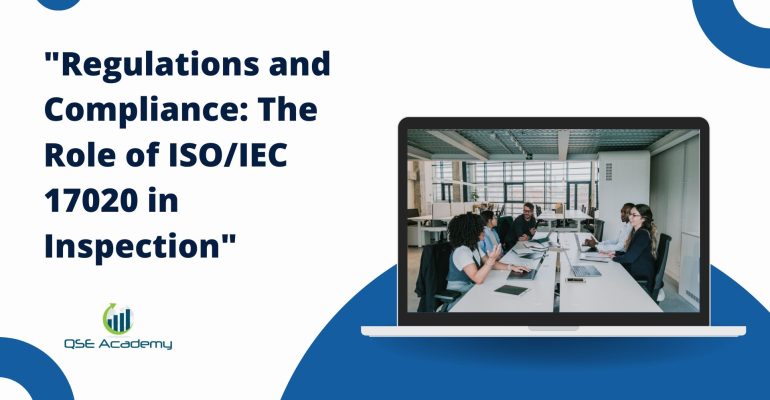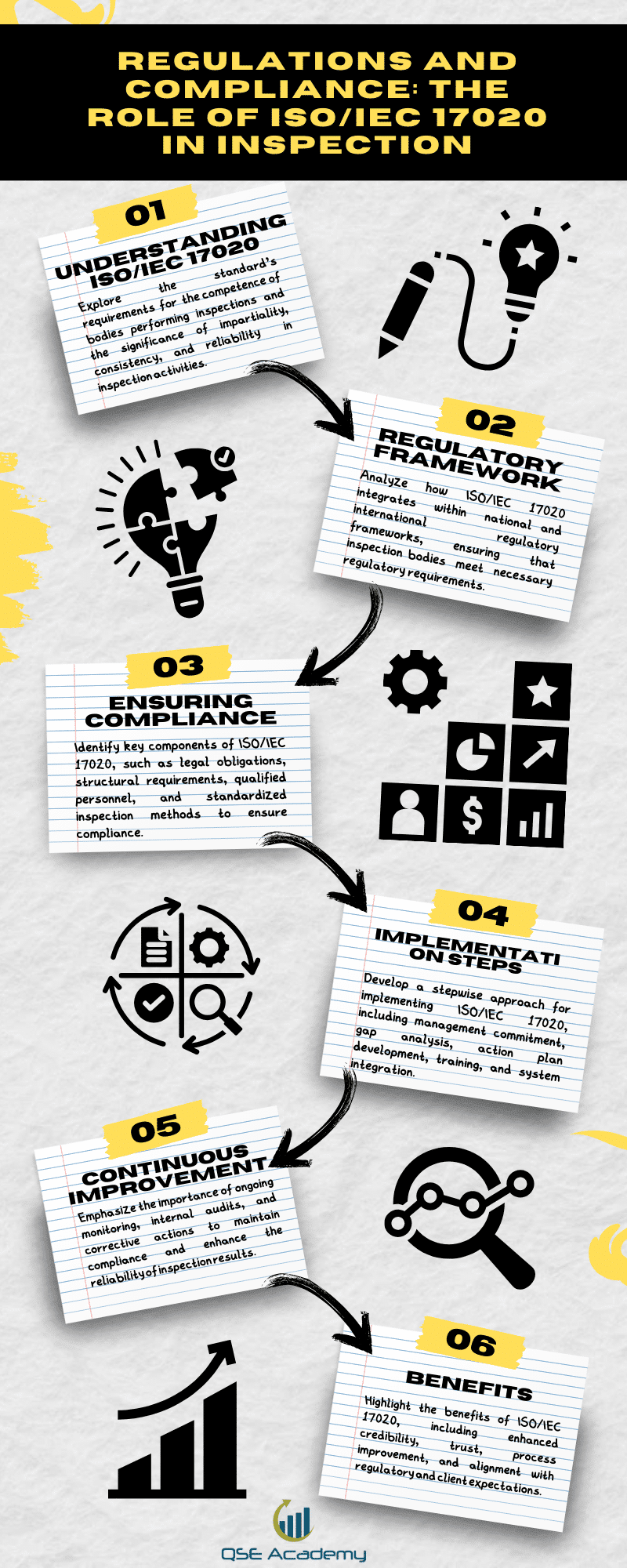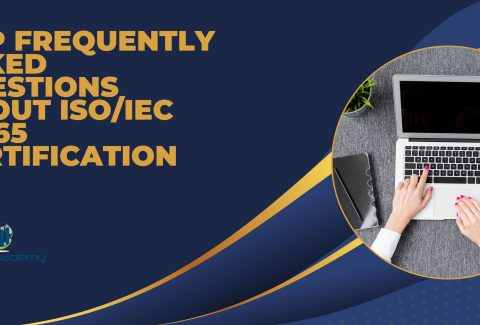Role of ISO/IEC 17020 in Inspection
In a world brimming with standards and regulations, ISO/IEC 17020 serves as a guiding star for inspection bodies. The landscape of conformity assessment can be complex and jargon-heavy, creating a labyrinth for organizations striving to ensure quality and regulatory adherence. As the cornerstone of credible inspections, ISO/IEC 17020 plays a pivotal role in harmonizing these processes globally.
This article delves into the intricacies of ISO/IEC 17020, untangling its significance within the regulatory framework. It demystifies the standard’s components essential for compliance, elucidates the implementation process, and showcases the tangible advantages for organizations. Circumnavigating through the text, we will explore impactful case studies before glimpsing into the evolving future of regulatory compliance under the watchful eye of ISO/IEC 17020.
Introduktion
ISO/IEC 17020:2012 is an internationally recognized standard that sets requirements for the competence of bodies performing inspection activities. It plays a pivotal role in determining the technical competence and impartiality of organizations that deal with examination of materials, products, installations, plants, processes, work procedures, or services. This standard is key for inspection bodies to attain accreditation, which fosters trust and assurance in their inspection services. Emphasizing the importance of consistent and reliable inspections, it covers elements like the methods and procedures of inspections, the training and qualifications of personnel, the rights and responsibilities of various parties involved, and the handling and control of inspection records.
Appropriately implemented, ISO/IEC 17020 enhances the credibility of inspection reports and certificates, ensuring that they are recognized and respected both domestically and internationally. This sets a benchmark for inspection services across various sectors, harmonizing inspection activities and enabling cooperation between regulatory agencies. Within this context, the main objective of this article is to delve into how ISO/IEC 17020 contributes to conformity and compliance in the operational practices of inspection bodies, assuring quality and reliability at every stage of inspection.
Förståelse av ISO/IEC 17020
ISO/IEC 17020 is an internationally recognized standard that specifies requirements for the competence of bodies performing various types of inspections. Adopted by the International Organization for Standardization (ISO/IEC), ISO/IEC 17020:2012 sets criteria to ensure that inspection services are conducted with impartiality, consistency, and reliability, ultimately enhancing trust in the work of inspection entities.
The standard covers diverse inspection activities, which can range from the examination of materials, products, installations, plants, processes, work procedures, or services to the inspection of design data. It is designed with a focus on the impartiality and consistency of inspection activities, ensuring that inspection reports and certificates issued by accredited bodies are both credible and authoritative.
Enforcing this standard is vital across various sectors, as it provides a systematic framework for the functions of inspection bodies. By meeting the regulatory and structural requirements specified in ISO/IEC 17020, bodies assert their technical competence. Additionally, they demonstrate the ability to operate in an impartial manner, a critical factor in maintaining the credibility of inspection results.
Inspection bodies are classified into three types based upon their independence and relationship with parties involved. These are:
- Type A: Fully independent bodies that are not involved in any activity other than inspection and related activities.
- Type B: Bodies that form a separate and identifiable part of an organization that also performs other functions but maintain operational independence.
- Type C: Bodies that perform inspections for their parent organizations and are involved in the design, manufacture, supply, installation, use, or maintenance of the items they inspect.
This delineation ensures appropriate levels of independence necessary to carry out fair and unbiased assessments. Meeting ISO/IEC 17020 standards is crucial for inspection agencies to operate effectively within regulatory frameworks and to be recognized by accreditation bodies and clients.
Regulatory Framework and ISO/IEC 17020
Regulatory requirements in the field of inspection are paramount to ensuring safety, quality, and compliance. Each industry is governed by sets of regulations and standards that dictate inspection activities. These inspections are vital for maintaining public safety, environmental protection, and adherence to statutory obligations. Regulatory bodies and authorities are established to enforce these requirements and to oversee the conduct and competence of inspection bodies.
One international standard that plays a critical role in the regulatory framework is ISO/IEC 17020:2012. This standard specifies requirements for the competence of bodies performing inspection and for the impartiality and consistency of their inspection activities. By aligning with ISO/IEC 17020, inspection services demonstrate their technical competence and operational integrity, which is essential for gaining trust among stakeholders and the public.
ISO/IEC 17020 outlines criteria for inspection bodies to integrate with national and international standards, ensuring a harmonious fit within the larger regulatory landscape. It also sets out the parameters for various stages of inspection, from the initial examination of materials to the issuance of inspection reports or certificates.
It is essential for these bodies to regularly engage in internal audits and corrective actions, both of which are integral components prescribed by ISO/IEC 17020 for continuous improvement and compliance. This not only fulfills structural requirements but also addresses the complexities of regulatory requirements, adapting to the evolving nature of legislation and standards pertinent to specific domains.
Moreover, ISO/IEC 17020 provides a framework for accreditation, against which an accreditation body can assess inspection agencies. The accreditation process itself plays a vital role in ensuring that inspection bodies remain compliant with both ISO/IEC 17020 and the regulatory requirements specific to their field.
Table: Integration of ISO/IEC 17020 within Regulatory Frameworks
| Komponent | Beskrivning |
| Tillsynsmyndigheter | Enforce industry-specific regulations, oversee inspection bodies. |
| ISO/IEC 17020 | Sets competence and quality standards for inspection bodies |
| Inspektionsorgan | Perform inspections, issue reports, in compliance with ISO/IEC 17020. |
| Ackrediteringsorgan | Assess and accredit inspection bodies against ISO/IEC 17020. |
| Compliance | Adherence to both national/international standards and ISO/IEC 17020. |
| Kontinuerlig förbättring | Through internal audits and corrective actions as per ISO/IEC 17020. |
In summary, ISO/IEC 17020 provides a foundational structure for inspection bodies to conform to the meticulous demands of regulatory frameworks, helping to maintain high levels of competence, impartiality, and consistency within inspection activities.
Key Components of ISO/IEC 17020 for Compliance
ISO/IEC 17020:2012 is an important international standard that specifies requirements for the competence of bodies performing inspection activities, ensuring they operate impartially and consistently. The standard outlines the criteria that inspection bodies must meet to be recognized as competent and reliable. Its adoption assures clients that inspections are conducted with integrity and expertise, leading to universally accepted inspection reports and certificates.
Allmänna krav Inspection bodies must adhere to stringent legal and contractual obligations, maintaining impartiality and independence in their operations to avoid conflicts of interest. Mechanisms for confidentiality and data protection are mandatory to establish trust with clients.
Strukturella krav The organizational structure should be clearly defined with outlined responsibilities and a management system in place to ensure oversight.
Krav på resurser Qualified personnel, along with the necessary infrastructure and equipment, are vital to carry out inspections effectively. Regular assessment and calibration of the equipment utilized for inspections are indicative of a body’s commitment to precision.
Krav på processen Inspection methods must be valid and appropriate for the services offered. Procedures for handling inspection items, sampling, testing, measurement, and reporting results should be standardized and consistent.
Krav på ledningssystem Implementation of a rigorous quality management system highlights a commitment to continual improvement. This includes concise document control, regular internal audits, management reviews, as well as corrective and preventive actions to address any non-conformance.
By ensuring compliance with these key components of ISO/IEC 17020, inspection bodies demonstrate to accreditation bodies their technical competence and operational integrity, which are fundamental in performing activities of inspection bodies.
Implementation of ISO/IEC 17020 for Regulatory Compliance
Implementing ISO/IEC 17020:2012, which governs the competence of bodies performing inspection, is pivotal for inspection bodies to ensure compliance with international standards. The journey to conformity with ISO/IEC 17020 requires a stepwise approach, starting with the commitment from top management. Such commitment is essential because it sets the organizational direction and allocates the necessary resources.
Conducting a gap analysis is the next vital step. Inspection bodies must ascertain their current position relative to the standard’s requirements. This diagnostic phase allows organizations to pinpoint the areas that need development before compliance can be achieved.
Developing an action plan is inherently tied to the insights gained from the gap analysis. This strategic blueprint outlines how the inspection body will address deficiencies, implement necessary changes, and enhance existing practices to align with ISO/IEC 17020. Training and competence development are integral at this juncture, ensuring personnel are proficient in new inspection methods and procedures.
A critical phase in the ISO/IEC 17020 implementation is the integration of the standard with existing systems. This harmonization involves aligning current processes with the standard’s requirements, guaranteeing that operational consistency and compliance across all inspection activities and records are maintained.
Monitoring and maintaining compliance through regular audits, both internal and external, is a continuous process that ensures ongoing adherence to inspection parameters and the timely identification of areas necessitating corrective actions. The establishment of continuous improvement mechanisms demonstrates a commitment to the evolution of inspection services and the enhancement of technical competence.
This implementation process emphasizes the structural requirements of inspection bodies and supports the achievement of reputable inspection reports and certificates. It guides bodies through the initial certification stage of inspection and prepares them for the eventual accreditation process administered by an accreditation body. ISO/IEC 17020 provides the foundation for a robust inspection process, covering examination of materials and the appropriate calibration of laboratories.
By committing to these implementation steps, inspection agencies enhance their credibility among regulatory agencies and stakeholders, ensuring they remain competent and competitive in a dynamic global marketplace.
Benefits of ISO/IEC 17020 for Regulatory Compliance
In the realm of inspection services, regulatory compliance is critical. ISO/IEC 17020 plays a pivotal role in ensuring that inspection bodies meet necessary requirements. This international standard specifies the criteria for the competence of bodies performing various types of inspections, assuring consistency and rigor in the inspection process.
One of the foremost benefits of ISO/IEC 17020 is enhancing credibility and trust. Conforming to this standard signals to clients and regulatory agencies that an inspection body adheres to globally recognized inspection methods and procedures, thereby ensuring the technical competence of its services.
Furthermore, ISO/IEC 17020 helps to build confidence among clients and stakeholders. As inspections are carried out in accordance with international standards, clients are assured of the quality and reliability of the inspection reports and certificates they receive. This builds trust and can often give an inspection body a competitive advantage.
Meeting regulatory and client expectations is another benefit, as this standard aligns inspection activities with the latest regulatory requirements. The standard ensures that inspection bodies are well-equipped to understand and fulfill their clients’ needs consistently.
In terms of process improvement, ISO/IEC 17020 encourages the standardization of inspection procedures, which in turn, improves inspection outcomes. The repetitive nature of standardized processes often leads to increases in efficiency and a decrease in error rates, ensuring the accuracy and reliability of inspection results.
ISO/IEC 17020 also serves to identify and address non-conformities. Through internal audits and control of records, this standard helps inspection agencies to recognize areas for improvement, encouraging corrective actions and preventive measures that reduce risks, enhance quality, and prevent liabilities.
In summary, ISO/IEC 17020 provides a wealth of benefits for regulatory compliance within inspection agencies, establishing a solid foundation of trust, efficiency, and quality in the inspection sector.
Framtida trender och utveckling
Inspection bodies must navigate an ever-changing landscape shaped by technological advancements and evolving regulatory requirements. Anticipated regulatory updates demand that organizations adapt swiftly to remain compliant. Furthermore, these changes profoundly affect how inspection activities and reports are conducted and formulated.
The integration of digital tools and the adoption of remote inspection techniques are leading to remarkable improvements in inspection efficiency and accuracy. Remote inspections allow for broader coverage and more frequent assessments without the need for inspectors to be physically present, which is invaluable when considering the restrictions imposed by global factors such as the COVID-19 pandemic.
As sustainability and risk management become more pronounced, inspection services are anticipated to pivot accordingly, aligning their methods and parameters to address these global trends. Inspection bodies are not only expected to refine their routines but also to enhance their inspection certificates to reflect these new priorities. Collaborative efforts are strengthening between regulatory agencies and inspection bodies to foster best practices.
To stay ahead, inspection bodies continuously examine materials and processes through the lens of the latest advancements, ensuring technical competence and the precise execution of the inspection process. The sector will also likely see an increased emphasis on inter-organizational cooperation, sharing insights, and strategies to elevate the quality and reliability of inspections across industries worldwide.
Table: Impact of Trends on Inspection Bodies
| Trend | Potential Impact |
| Digital Tools & Remote Tech | Increased efficiency, expanded coverage |
| Regulatory Changes | Necessity for agile adaptation, continuous training |
| Sustainability & Risk Focus | Modification of inspection parameters |
| Collaborative Efforts | Shared best practices, improved standards |
This future-oriented approach ultimately serves to uphold the integrity and reliability of inspection bodies, echoing the stringent criteria set by ISO/IEC 17020 and comparable international standards.
Slutsats
In conclusion, adherence to ISO/IEC 17020:2012 is pivotal for inspection bodies aiming to establish a mark of trust and excellence in their inspection services. The standard acts as a cornerstone in ensuring that the competence of bodies performing inspection is rigorously evaluated and that their inspection activities meet stringent international requirements. More so, the benefits of implementing ISO/IEC 17020 are multifold, enhancing not only the technical competence and consistency of inspection reports and certificates but also instigating the need for corrective actions and internal audits that foster continual improvement.
Certification to ISO/IEC 17020 paves the way for inspection agencies to demonstrate their ability to operate impartially and competently, leading to improved process efficiency and stakeholder credibility. In an era where regulatory requirements are becoming ever more complex, the alignment of inspection methods, parameters, and activities with ISO/IEC 17020 becomes a catalyst for transparency and reliability.
Embracing a culture that values the maintenance and continuous enhancement of quality is vital. Inspection bodies are thus encouraged to pursue ISO/IEC 17020 certification not just for compliance, but as a strategic investment in their service quality and integrity. Keeping abreast of updates to standards is paramount to not just meet, but exceed, the expectations of regulatory agencies and consumers alike.
Letar du efter fler resurser om ISO 17020?
Om du tyckte att den här artikeln var till hjälp kan du utforska våra premiumresurser som är utformade för att hjälpa dig att uppnå ISO 17025-certifiering på ett effektivt sätt:
- 📦 Komplett dokumentationspaket för ISO/IEC 17020 2012: Få alla viktiga mallar och dokument du behöver för en snabb och enkel implementering.
- 🎓 Onlinekurs om ISO/IEC 17020 2012 : Delta i vår omfattande utbildning för att lära dig de viktigaste begreppen och de praktiska stegen mot certifiering.
- 📋 ISO/IEC 17020 2012 Checklista: Ladda ner vår detaljerade checklista för att säkerställa att du har täckt varje steg i processen.
Dessa resurser är skräddarsydda för att tillgodose dina behov och säkerställa en smidig certifieringsresa. Utforska dem redan idag och kom ett steg närmare framgång!














